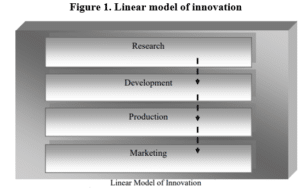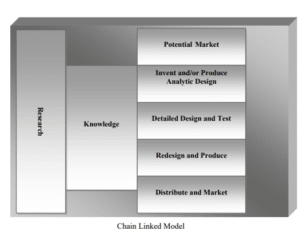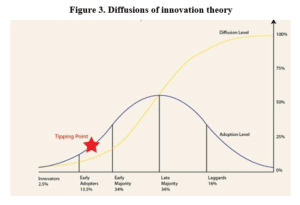MAN505 Literature Review Assignment Sample
Here’s the best sample of MAN505 Literature Review Assignment, written by the expert.
Introduction
It is recognized in the literature that global market place is leading towards user driven innovation and despite of relative utilization of innovation, user led innovation remain it’s in early stages. The literature review contributes by exploring the conceptual issues of user led innovation and indicate the nature of user led innovation with interaction of user with company, design, brand and their complementary behaviour for creating excellent user experience. The theoretical propositions are also studied for future studies in the similar area of research. The user led innovation helps the companies to compete in global market by development of end user requirements. And the users are considered as main resource for companies for development of products and services because user led innovation are carried out by partner companies or end user (Magnusson 2003). The needs and wishes of users are perceived from their level of involvement in generation of idea, design and development, feedback etc.
This study is mainly concerned with the involvement of users in the innovation process. There are different phases of innovation process i.e. exploration, creation of idea, selection of idea and commercialization. The user gets involved in the innovation process but do not follow specific guidelines related to the involvement of different type of user in different phase of innovation process. The main purpose of study is to fill the gap in this concern. The different types of users involved in the innovation process are ordinary users, corporate users, lead users, professional users. The companies are involved in creating innovation through user led innovation and it is considered that utilization of different users in different innovation phases is more beneficial for companies in the competitive market place.
Articles Reviewed
- Alam 2002, ‘An exploratory investigation of user involvement in new service development’, Journal of the Academy of Marketing Science, vol 30, no. 3, pp. 250-261.
- Balasubramanian, PJ 2002, ‘Exploring the Implications of M-Commerce for Markets and Marketing’, Journal of the Academy of Marketing and Science, vol 30, no. 4, pp. 348-361.
- Christiansson, SRAO 2008, ‘User driven innovation in the building process’, Journal of Tsinghua Science and Technology, vol 13, no. 1, pp. 248-254.
- Lettl 2007, ‘User involvement competence for radical innovation’, Journal of engineering and technology management, vol 24, no. 1-2, pp. 53-75.
- Magnusson 2003, ‘Benefits of involving users in service innovation’, European Journal of Innovation Management, vol 6, no. 4, pp. 228-238.
- Magnusson, MK 2003, ‘Managing User Involvement in Service Innovation Experiments with Innovating End Users’, Journal of Service Research, vol 6, no. 2, pp. 110-111.
Methodology
The study has adopted grounded theory approach in alternative to the qualitative research. The grounded theory includes flexible and systematic guidelines for collection and analysis of qualitative data for construction of theories grounded in the data. This theory utilizes the data for development of theoretical framework without the development of hypothesis based on the literature review. The results of grounded theory are set of hypotheses based on the empirical data about the relationship between different concepts.
Theoretical aspects
The theory related to domain of research is covered under this section. The main concept of innovation, models of innovation, different types of users, and methods of user involvement in user led innovation and advantages of involving users in the innovation process are explained in detail. Innovation is considered as an introduction of new thing or modification of already existing idea in the related subject. The innovation is a process of modifying the existing or launched ideas (Balasubramanian 2002). The main goal of innovation was to serve users in best manner and create maximum value for the users by serving new or better things. It is one of the primary sources of good economy and also leads to high level of productivity. The nature of innovation is multidisciplinary that ranges from analysis of innovation in cultural, economic and social context to psychological literature exploring innovative minds. There is a significant different between invention and innovation. When the idea regarding any product or service is made for the first time, it is called innovation and when the idea is commercialized, it is innovation (Magnusson 2003). There are many innovations that have revolutionized the world like wheel, paper, alphabets etc. Today, lot of innovations has taken place such as vehicles, airplanes, computers, and telecommunications. Earlier, innovation has not got the attention and then, Fagerberg (2005) have introduced the theory of innovation as the efforts of individual who introduces the idea in the market. The theory was limited to firms, market and industries and later, various theories were developed for better understanding of study.
Main Findings
Innovation models
There are various process innovation models and they are different in different ways such as terminology, phases, terminology etc. The linear model of innovation is explained in below figure (Figure 1).

The linear model deals with the deforming the reality of innovation in various ways. For example, the feedback is considered for evaluation of performance but there are no feedback linked pathways in the linear innovation process (Magnusson 2003). For further consideration of arising innovation, Chain linked model of innovation is also introduced as shown in below figure (Figure 2).

The chain linked model of innovation describes varied level of contributions of research and development along with different knowledge sources at multiple phases of innovation process. The chain linked model deals with the contribution of innovation in the real world in practice manner.
User Led Innovation
Lettl (2007) have identified the gap existing between the disciplines of innovation and user led innovation and noted that user led innovation is adopted in different phases of innovation process. The process of innovation is conducted in different phases i.e. generation of idea, execution/selection and lastly, commercialization. The main innovation sources are research driven, price driven and user driven. Most of the companies are competing with each other by focusing on different innovation sources and some companies specialize in focusing on single source of innovation (Christiansson 2008). The study concentrates on user led innovation which is systematic mapping of needs of customers with the consideration of required skills to translate the existing knowledge into innovation. The phases in innovation process are detailed below.
- Exploration: The front end of innovation has to be clarified before the execution related activities takes place. This phase aims to understand the current and future results related to the needs, situations, desires and problems of the customers. The end results of this phase is the achievement of customer insights and fetching the details related to the beliefs and perceptions of users related to the unsolved problems.
- Generation of idea: This phase deals with the identification of innovative ideas and pre-selection activities(Magnusson 2003). In the case of pull innovation, the demand of market provides the innovation grounds whereas in push innovation, it starts with the technical ideas or interventions.
- Selection/Execution: The investigation of feasibility and ascertained profit of innovation is conducted in this phase. The selection means the selection of innovative ideas on the basis of their potential success rates.
- Commercialization: The main purpose of generating idea and innovation is to commercialize it in the market. The innovation is commercialized in the selected and targeted market in this specific phase(Alam 2002). This innovation phase also evaluates the likes and dislikes of users along with the usability.
User led innovation is systematic approach for development of products and services, building the adoption of life, identity, needs of users including unrevealed requirements. It is indicated that competition in the areas of innovation is increasing at fast pace and mostly, it is related with new technologies and the main focus is to understand the demands and needs of end users. The companies are required to meet the needs of users that are identified by different analytical methods and the specifications of users. The user led innovation serves the purpose of understand the needs of users and developing the solutions that have capacity to satisfy the requirement and wishes of users (Christiansson 2008). The competition is mainly focused on the understanding of emerging needs of users and capacity to understand the design and development of products or services. It fulfils the needs of customers in such a manner that there are no competitors that has the similar ability to match the same. The growing utilization of systematic phenomenon has led to the growth of user led innovation. The concept of user led innovation plays a vital role in development of products or services for fulfilment of desires and needs of users. There are different methods used in the innovation process to find out the needs of users but have some common features.
According to Lettl (2007), the users are considered as innovators and they have specific characteristics such as incentive for innovation and willingness to experiment new things. The first time innovation is not perfect from the user side but it definitely moves the users forward for fulfilment of their requirements and success is also linked to the solution of their problem. It is indicated that users are not working full time for the invention of new products and services but live their normal life. Therefore, the feedback of users is important but the whole innovation process cannot depend on the requirement of users. At the same time, it is indicated that the user innovation matters to users as well because it helps them in meeting their customized requirements, personal needs that helps in dealing with their problems (Fagerberg 2005). Increasingly, the organizations have also realized that the user led innovation is a rich source and need to be tapped specially for two important reasons. The first reason of involving users in the innovation process is at front end innovation that can improve the ideas leading to innovation. But at the same time, it is also important to downstream in the further stages of innovation. The diffusion of innovation is mainly influenced by the compatibility of users in context to lifestyles and the adoption of users in context to the innovation. The ideas of innovation need to come from people who have good possibilities of acceptance and adaptation. The rich source for organizations to be tapped is indicated in the below figure (Figure 3)

Methods of user involvement
There are different technologies that are extensively user for the personal and professional practices and performing the tasks in seamless manner. Therefore, the main focus has to be on the personal use situations while developing the products and services. There are different aspects of social and cultural context that have influence on the selection, adoption and utilization of products and services. In design phase, the challenges for acquisition of socio-cultural aspects need to be taken and put them in the future scenario for creation of ideas (Lettl 2007). The designing of new scenarios increases the risk of making false decisions in context to design. The iteration of design evaluation is one of the beneficial ways for designing context. In traditional innovation methods, companies try to understand the needs of users by different techniques like survey, test groups, prototypes etc. The methods of innovation are categorized as follows:
- Voice of customer – The third party services can be hired for finding the customer needs and in product focused companies, brainstorming sessions and prototype solutions are developed for understanding the user needs(Magnusson 2003). The introduction of new product experiences is given to users and develops the infrastructure for innovative products.
- Lead user method – The companies work as partners in cooperation with lead users. In this method, the products are used by lead users and the problems are solved by themselves. The application of this method is very cost effective and also reduces the time of product development.
- Mock-up – The users are involved actively by the participation activities within the design projects. The dummy physical demonstrations of products are given to users for simulation of different tasks, procedures and layouts(Fagerberg 2005).
- Prototyping of patchwork – The user driven practices are conducted to fix the spontaneous issues and accentuate the importance of involving users in the development of product or reducing the gap between conception and realization of idea.
Some of the other methods to involve users in the innovation process are daily visits of potential customers, diary search method for exploring the interest areas within the innovation process, understanding of insights for realization of direct interaction, explorative interviews to gain information about problems and needs related to products and services, information pump for discussion of ideas related to current and future products or services, ideation workshop for exploring the potential of users and generating the standard designs, evaluation techniques for exploring the information related to various areas of utilization, modification of products, detailed preferences and behaviour of users, test market simulation for understanding the usage of products and services in virtual environment, online surveys for exploring the knowledge and expertise of users in the concerned areas.
Innovation in practice
The concept of innovation is very important in the commercial success of products and services and depends heavily on identifying the requirement of customers. The different concepts of products and services, mobility, different methods to involve the users in process of innovation are conducted to bring innovation of products and services within the industry. According to Christiansson (2008), the innovation concept have driven many industries and contributed a lot to the technology field. The potential for utilization of products and services exists in different innovative ways for many social and cognitive activities such as arranging meetings, interviews, games, chatting etc. The user led innovation has a vital role in the field of information and communication technology as it provides support in development of specialized competence application. The technology is developed through process, deeds, and performance for the betterment of entity itself or another entity. The knowledge is transmitted through embedded knowledge and intermediate products are utilized as the device the value generation process (Alam 2002). The user led innovation provides possibilities of increasing the mobility and allowing users to participate in the service processes and achieve the outcomes.
There are many benefits of involving users in the process of innovation and execute the process as user led innovation. It is indicated that companies do not categorize the types of users but the different users are involved in the different phases of innovation process. The general types of users are ordinary users, professional users, partner companies. These users are involved in different phases of innovation process according to their expertise. The user involvement in innovation process is advantageous for companies but users should be involved in the early phases such as design phase. Furthermore, the companies should develop the products and services according to the needs and demands of users because it provides an added competitive edge (Lettl 2007). The ideas of users regarding the particular products and services provide an inspiration to the professional development team and it is up to professionals to screen these ideas in the development process. In this manner, the companies can compete in market while developing innovative products and services. The involvement of users is beneficial because the negative feedback of customers after the launch of product and services will not contribute to the company and in case of considering feedback in designer development phase, the products and services can be provided according to the consideration of feedback. The early involvement of users increases the possibilities of success of products and services in the competitive market.
Limitations
The limitations of this study are connected to the perspectives of research implications. The study implies the aspect of companies and not the users. The research based on users would have revealed additional and better insights in context to user led innovation. Another limitation is the small set of data. This study is an exploratory study with the main aim of obtaining theoretical aspects for further empirical research.
Conclusion
The study has contributed to the understanding the concept of innovation, innovation process, user led innovation, methods of user involvement in innovation process and benefits of involving user in the innovation process. The user led innovation is mainly related with information and communication technology because technology is one of the user leading industries. It is indicated in the study that companies should follow the methods of user involvement for better and innovative products and services. The involvement of user provides innovative ideas and leads to sophisticated products and services and also increases the possibilities of better acceptability in the society. The aim of study has been fulfilled by understand in different user led innovation methods for encouraging involvement of users in the innovation process in companies. It is indicated that the companies should work in cooperation with users for development of innovative products and services to lead in the competitive market.
References
Alam 2002, ‘An exploratory investigation of user involvement in new service development’, Journal of the Academy of Marketing Science, vol 30, no. 3, pp. 250-261.
Balasubramanian, PJ 2002, ‘Exploring the Implications of M-Commerce for Markets and Marketing’, Journal of the Academy of Marketing and Science, vol 30, no. 4, pp. 348-361.
Christiansson, SRAO 2008, ‘User driven innovation in the building process’, Journal of Tsinghua Science and Technology, vol 13, no. 1, pp. 248-254.
Fagerberg 2005, ‘Innovation: A guide to literature’, The Oxford Handbook of Innovation.
Lettl 2007, ‘User involvement competence for radical innovation’, Journal of engineering and technology management, vol 24, no. 1-2, pp. 53-75.
Magnusson, MK 2003, ‘Managing User Involvement in Service Innovation Experiments with Innovating End Users’, Journal of Service Research, vol 6, no. 2, pp. 110-111.
________________________________________________________________________________
Know more about UniqueSubmission’s other writing services:

